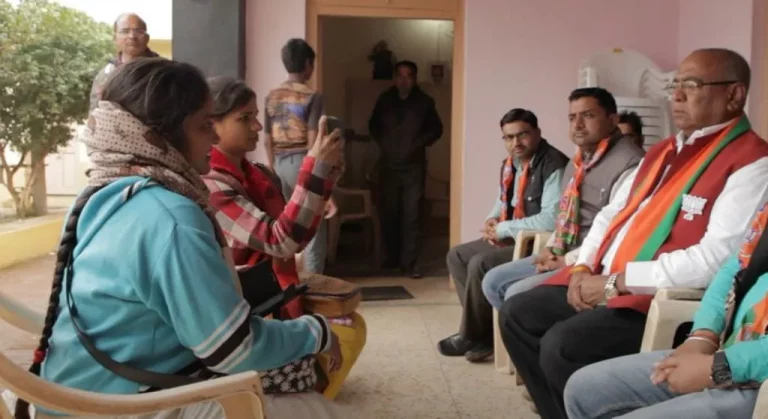Thanks to documentary filmmakers in India. If this film Writing With Fire had not been shortlisted for the Oscars 2022, we would perhaps never have known of the existence of a weekly newspaper brought out both in Hindi and English exclusively by women in Uttar Pradesh.
The film has been jointly directed by Rintu Thomas and Sushmit Ghosh who are based in Delhi but researched the film by journeying through different parts of Uttar Pradesh to meet these gutsy women to find out how they work and what obstacles they overcome every day of their working life. Khabar Lahariya has been in existence for 20 years now but sadly, we never seem to have heard of the paper or about the women who run it despite UP being one state notorious for its marginalisation and torture of women. Among numerous awards, the film won a double at the Sundance Film Festival – the Special Jury Award and the Audience Award. It has been screened at over 90 festivals and won 28 international awards.
Sushmit is a 2021 IDA Courage Under Fire Award Honoree and a Sundance Fellow. 2021 IDA Courage Under Fire Award Honoré, Rintu is also an IDA Logan Elevate grantee and a Sundance Fellow. They were shocked out of their wits because they saw the name of their film announced while listening to the news on TV listing the short list for Oscars 2022. For Best Documentary Feature, after Ascension, Attica, Flee and Summer of Soil, Writing With Fire found a mention. The documentary was nominated for the Best Documentary Feature at the 94th Academy Awards. They have previously worked on three documentaries together – Miracle Water Village, Dilli and Timbuktu.
Though the newspaper now has a 24-strong team, the film focuses on three women – Meena who founded the paper, Suneeta Prajapati and last but never the least, Shyamkali, who joined Khabar Lahariya ten years ago. Apart from capturing these three women while they go about their jobs, engaged in field research, talking to people and to the camera, the film throws light on women journalists learning how to use a smartphone for making videos. These young women are trying their best to get accustomed to modern technology. They want to make sure that their reach widens. Their battle is bigger than their home or the everyday workplace problems. But there are problems at home too. Meena was married at 14 and had little institutional education. But she jumped hurdles to acquire an education and also, to bring out a newspaper. They investigate the incompetence of the local police force, listen to and stand by victims of caste and gender violence, and challenge long-standing, harmful practices that lead to injustice and intimidation.

Instead of opting for a voice-over for a commentary, the directors very rightly asked the three women to narrate their own tales and the film is dotted with their forthright talking into the camera, discussing stories with their colleagues at story-meetings and now proudly maintain a website where anyone is welcome to read their newspaper.
The paper features stories on rape and human rights abuses, illegal mining, lack of toilets, roads, and electricity, and politics. They ask meaningful questions of men in power and hold folks accountable. Meera believes “journalism is the essence of democracy,” and she leads her team without fear or favour to uncover stories, reveal unheard of stories which the mainstream media is either not aware of, or does not care to carry.
Shyamkali says she never stepped out of her home before she joined Khabar Lahariya. A financial crisis at home led Shyamkali to Khabar Lahariya in 2010. A decade later, armed with a smartphone and steely determination, she is KL’s only reporter from Mahoba. Her quest for truth has taken her to different places. Shyamkali, along with her colleague, is risking her life to report the truth.
One can safely state that the film documents, in a manner of speaking, the resistance of rural Dalit women in Uttar Pradesh with Khabar Lahariya as the agency, the message and the weapon. Through their stories they have researched down 20 years, they are struggling with their aim to resist and rebel against their subjugation, firstly because they are women and secondly because they are Dalit. If they are Dalit, they are also very poor so it is a three-pronged attack they are fighting with every passing day. The fourth is that if they are Dalit, it also follows that they are desperately poor.
Meena was married at 14 and had little institutional education. But she jumped hurdles to acquire an education and also, to bring out a newspaper. They investigate the incompetence of the local police force, listen to and stand by victims of caste and gender violence, and challenge long-standing, harmful practices that lead to injustice and intimidation.
They are using their journalism as an instrument and a weapon to resist and reject the position of ‘victim ‘, often the label they are pasted with. They are successfully and strategically mobilizing their fellow women to raise voices on the issues of patriarchy and caste violence. Their success is defined by the twenty years they have been able to sustain their outlet Khabar Lahariya.
The paper now defines itself as a “Digital Rural News Network.” Independent and Public-Spirited Media Foundation has provided part financial support to Khabar Lahariya for reporting and publishing stories of public interest. IPSMF does not take any legal or moral responsibility whatsoever for the content published by Khabar Lahariya on its website or on any of its other platforms. The newspaper now comprises 24 female journalists. It has created a parallel discursive arena where the members of subordinated social groups invent and circulate a counter discourse.
“When Dalit women succeed, we can redefine what it means to be powerful,” says Meera who, after marrying at 14, bucked societal expectations by continuing her education. Suneeta has also redefined herself, taking her childhood experience of working in an illegal mine and using her community connections to pull back the curtain on ongoing criminality.
The film, as fearless as the subject it deals with, shows how the journalists covered the Indian election cycle, as Prime Minister Narendra Modi sought a second term. Meera is captured n camera, dogged in her pursuit of interviews with a rising star in the youth organisation Hindu Yuva Vahini – a vigilante outfit spreading anti-Muslim rhetoric.
One frame shows a young woman journalist who goes to cover a story, confronting a group of young men who are openly hostile. One of the men says, “Media companies give journalists cars, bikes, mobiles; you don’t have anything.”He has the gumption to ask her if she takes bribes for publishing the story on the front page. Her prompt response is, “We don’t take bribes to publish news.” He then asks her to just leave. Would he ever have had the gumption to ask a male journalist or a city-based woman journalist the same question, or behave so rudely? The very fact that these women journalists are fearless, frank and bold puts the back up of most of the men in the area they live, work and function in.
Sushmit Ghosh, while speaking to Amanpour and Company on YouTube, said that newsrooms in India are dominated by middle-aged upper-caste men who decide the news to be run. The film steers away from explaining how the weekly newspaper came into being and who were the ones who pioneered it. But it tells us in no uncertain terms that these women have worked out a fine balance between their domestic lives and their work lives. In the film, we can see and hear Meena’s husband say, “I never expected them to achieve anything.” The answer to this lies in the film and in the subjects the film talks about and follows from beginning to end.
Shoma A. Chatterji is a freelance journalist, film scholar and author based in Kolkata. She has won the National Award twice, in 1991 and 2000. She has authored 26 published titles of which 14 are on different areas of Indian cinema. She holds two Masters Degrees and a Ph.D. in History (Indian Cinema). She has also won a few Lifetime Achievement Awards from different organizations over time.








